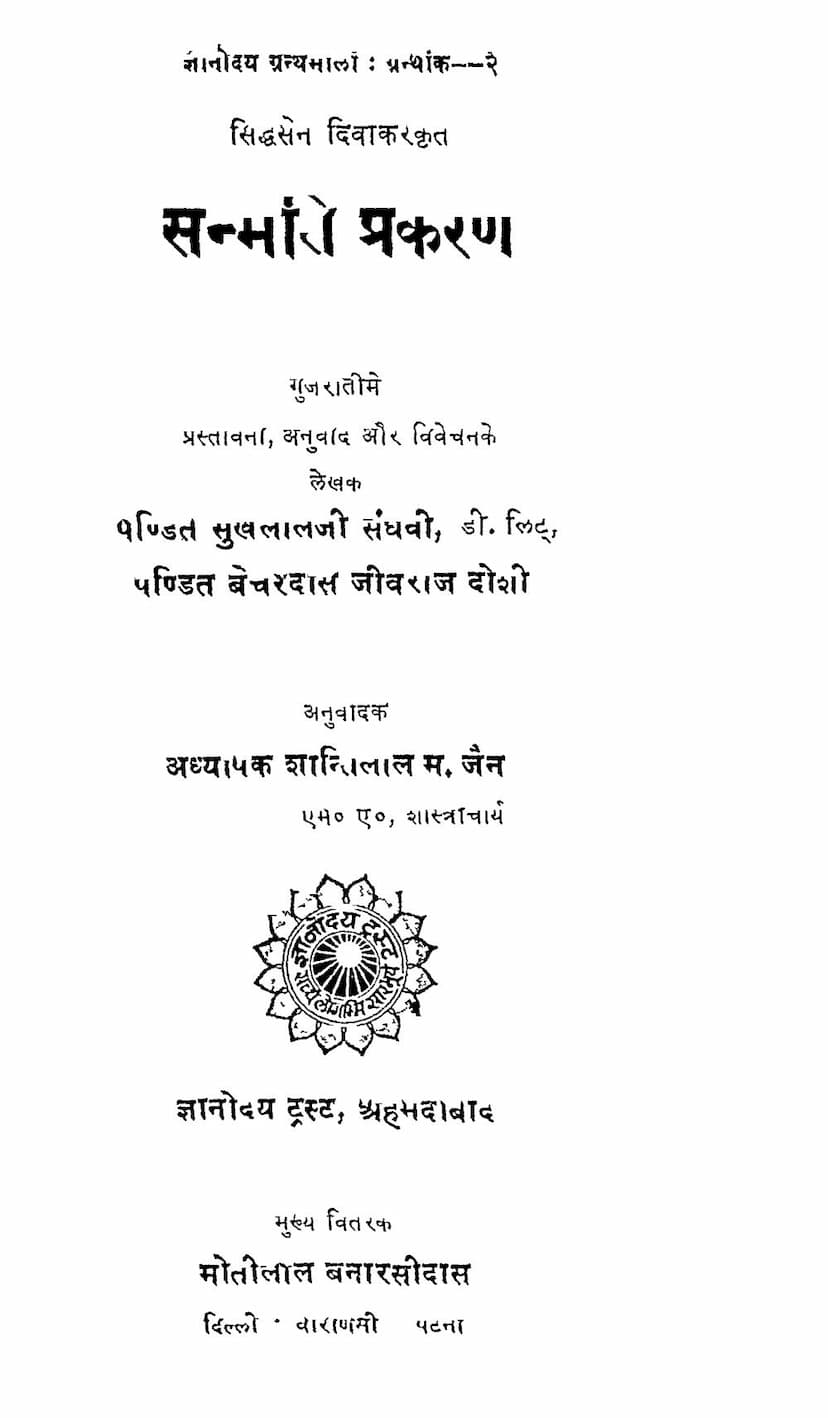Sanmati Prakaran
Added to library: September 2, 2025

Summary
This document is a comprehensive summary of the Sanmati Prakaran by Acharya Siddhasena Divakara, with extensive commentary, translation, and analysis by prominent Jain scholars Pandit Sukhlalji Sanghavi and Pandit Bechardas Jivraj Doshi. Published by Gyanodaya Trust, Ahmedabad, in May 1962 (Vikram Samvat 2019), this work is the Hindi translation of the Gujarati version, which was itself based on the Prakrit text and Acharya Abhayadeva's Sanskrit commentary.
Key aspects of the document include:
-
The Text and Its Editors: The 'Sanmati Tark Prakaran' is a foundational Jain text on logic and philosophy, originally composed in Prakrit by Acharya Siddhasena Divakara. The Sanskrit commentary by Acharya Abhayadeva is also significant. The meticulous editing and publication of the Gujarati and Hindi versions by Pandit Sukhlalji Sanghavi and Pandit Bechardas Jivraj Doshi, with contributions from Pandit Shantilal M. Jain for the Hindi translation, highlight their immense contribution to Jain scholarship.
-
The Life and Works of Pandit Sukhlalji Sanghavi: A significant portion of the introductory material (pages 5-16 of the provided text) is dedicated to the biography and literary contributions of Pandit Sukhlalji Sanghavi. It details his intellectual prowess, his scholarly pursuits, his commitment to Jain philosophy and logic, his extensive literary output (including translations and commentaries on numerous Jain works), and his broader contributions to Indian culture and education. His life journey, marked by early adversity and a profound dedication to scholarship, is portrayed as an inspiration.
-
The 'Sanmati Prakaran' Itself:
- Author: Acharya Siddhasena Divakara, also known as Divakara.
- Subject Matter: The text primarily deals with Jain logic, particularly the theory of Anekantavada (the doctrine of manifold aspects) and Syadvada (the doctrine of conditional predication). It systematically analyzes various Nayas (standpoints or perspectives) and their application in understanding reality.
- Structure: The work is divided into three Kandas (sections):
- Pratham Kanda (First Section): Focuses on Nayas (standpoints) and their application, particularly the distinction between Dravyanay and Paryayanay. It delves into the nature of reality, examining it from different perspectives and highlighting the limitations of each exclusive viewpoint.
- Dwitiya Kanda (Second Section): Discusses the nature of knowledge and perception, the relationship between soul and body, the doctrine of causality, and the synthesis of various philosophical views. It critically examines the concepts of consciousness, karma, and liberation.
- Tritiya Kanda (Third Section): Continues the philosophical discussion, focusing on the nature of reality, the limitations of knowledge, the importance of synthesis in understanding diverse philosophical standpoints, and the role of reason and scripture in Jain epistemology. It also touches upon the historical context of Jain philosophy and its interaction with other Indian philosophical schools.
- Key Concepts: The text elaborates on fundamental Jain concepts such as:
- Anekantavada (Non-absolutism): The doctrine that reality has manifold aspects and can be viewed from different standpoints.
- Syadvada (Conditional Predication): The theory that predication is always conditional, expressed through the word 'syat' (perhaps/in some respect).
- Nayas (Standpoints): The text meticulously analyzes various Nayas, especially Dravyanay (substantial standpoint) and Paryayanay (modal standpoint), explaining their respective scopes and limitations.
- Saptabhangi (Sevenfold Syllogism): The application of Syadvada through seven possible predication modes about any given reality.
- Soul (Jiva) and Matter (Pudgala): The text discusses their nature, relationship, and the process of bondage and liberation.
- Causality: The discussion includes various theories of causation, including the Jain perspective.
- Epistemology: The nature of knowledge, perception, and valid means of knowledge (pramanas) are explored.
-
Historical Context and Scholarly Debate: The document extensively discusses the historical context of Acharya Siddhasena Divakara, his time period, his relationship with other philosophers like Dignaga, Dharmakirti, and Samantabhadra, and the various scholarly debates surrounding his era and works. It references historical accounts, inscriptions, and comparative analysis of Jain and non-Jain philosophical texts to ascertain these details. The document also highlights criticisms and counter-criticisms related to the interpretation of Siddhasena's works, particularly by figures like Pt. Jugalkishore Mukhtar.
-
The Significance of 'Sanmati Prakaran': The work is considered a cornerstone for understanding Jain logic and epistemology. Its systematic approach to Nayas and Anekantavada provides a framework for comprehending the complexities of reality and knowledge, offering a balanced and nuanced perspective that avoids dogmatism and absolutism. The detailed commentary and translation in this Hindi edition make this profound philosophical work accessible to a wider audience.
-
Gyanodaya Trust and its Mission: The publication is presented by Gyanodaya Trust, Ahmedabad, an organization dedicated to promoting Jain education and culture. The preface highlights the Trust's commitment to publishing valuable Jain literature.
In essence, this document is not just a translation of 'Sanmati Prakaran' but a scholarly edition that places the work within its historical, philosophical, and literary context, enriched by the biographies and insights of eminent scholars. It serves as an invaluable resource for anyone seeking a deep understanding of Jain philosophy, logic, and the intellectual legacy of Acharya Siddhasena Divakara.